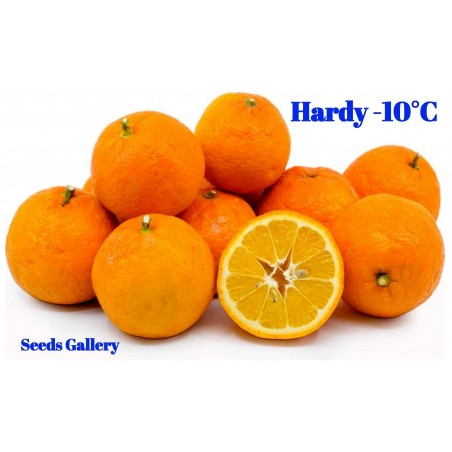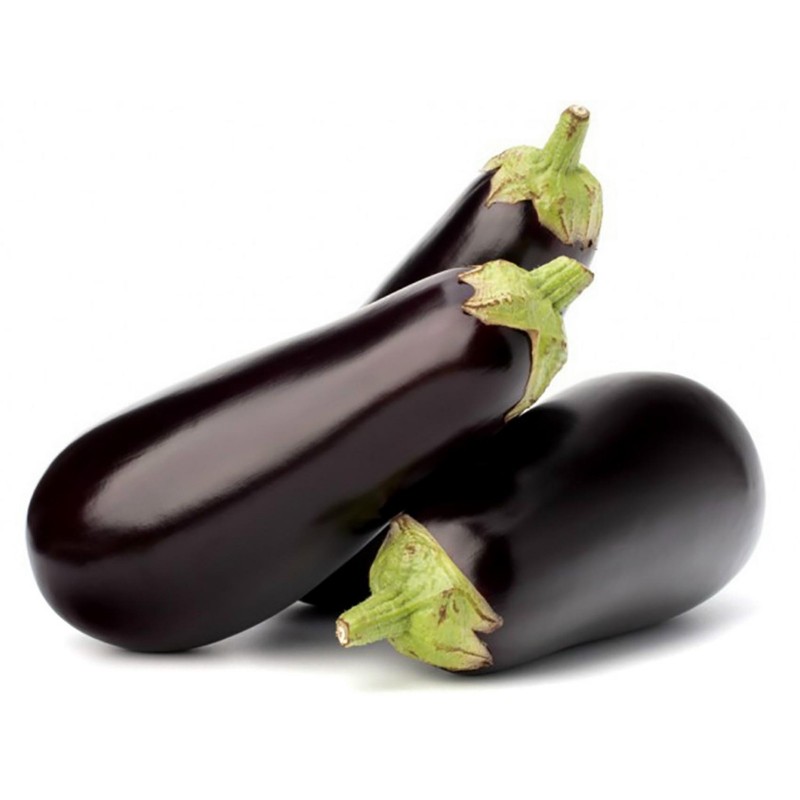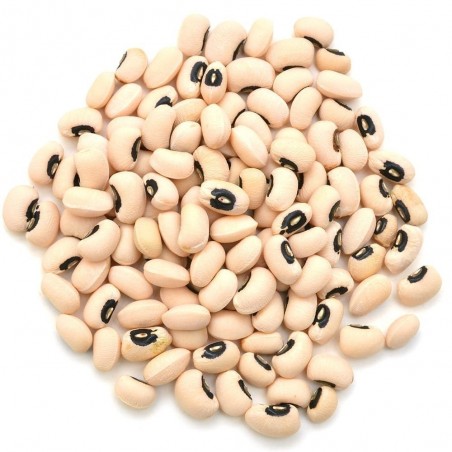
Medium Long Eggplant Seeds
Medium Long Eggplant Seeds Domestic (Aubergine)
Price for Package of 200 seeds (1g).
Early medium maturing variety, tolerant to heat and humidity, vigorous growth, strong diseases resistance, long harvest period, long straight fruit, beautiful shape, glossy purple skin
Medium Long Eggplant Seeds Domestic (Aubergine)
Price for Package of 200 seeds (1g).
Health properties
| Eggplant, raw | |
| Nutritional value per 100 g (3.5 oz) | |
| Energy | 102 kJ (24 kcal) |
| Carbohydrates | 5.7 g |
| - Sugars | 2.35 g |
| - Dietary fiber | 3.4 g |
| Fat | 0.19 g |
| Protein | 1.01 g |
| Thiamine (vit. B1) | 0.039 mg (3%) |
| Riboflavin (vit. B2) | 0.037 mg (3%) |
| Niacin (vit. B3) | 0.649 mg (4%) |
| Pantothenic acid (B5) | 0.281 mg (6%) |
| Vitamin B6 | 0.084 mg (6%) |
| Folate (vit. B9) | 22 μg (6%) |
| Vitamin C | 2.2 mg (3%) |
| Calcium | 9 mg (1%) |
| Iron | 0.24 mg (2%) |
| Magnesium | 14 mg (4%) |
| Manganese | 0.25 mg (12%) |
| Phosphorus | 25 mg (4%) |
| Potassium | 230 mg (5%) |
| Zinc | 0.16 mg (2%) |
| Percentages are relative to | |
A 1998 study at the Institute of Biology of São Paulo State University, Brazil, found eggplant juice to significantly reduce weight, plasma cholesterol levels, and aortic cholesterol content in hypercholesterolemic rabbits.[13]
The results of a 2000 study on humans suggested S. melongena infusion had a modest and transitory effect, no different from diet and exercise.[14]
A 2004 study on humans at the Heart Institute of the University of São Paulo found no effects at all and did not recommend eggplant as an alternative to statins.[15]
The nicotine content of aubergines, though low in absolute terms, is higher than any other edible plant, with a concentration of 0.01 mg per 100 g. The amount of nicotine consumed by eating eggplant or any other food is negligible compared to being in the presence of a smoker.[16] On average, 9 kg (20 lbs) of eggplant contains about the same amount of nicotine as a cigarette.
Allergies
Case reports of itchy skin or mouth, mild headache, and stomach upset after handling or eating eggplant have been reported anecdotally and published in medical journals (see also oral allergy syndrome). A 2008 study of a sample of 741 people in India, where eggplant is commonly consumed, found nearly 10% reported some allergic symptoms after consuming eggplant, while 1.4% showed symptoms within less than two hours.[17] Contact dermatitis from eggplant leaves[18] and allergy to eggplant flower pollen[19] have also been reported. Individuals who are atopic(genetically predisposed to developing certain allergic hypersensitivity reactions) are more likely to have a reaction to eggplant, which may be because eggplant is high in histamines. A few proteins and at least one secondary metabolite have been identified as potential allergens.[20] Cooking eggplant thoroughly seems to preclude reactions in some individuals, but at least one of the allergenic proteins survives the cooking process.
| HEIRLOOM ? | Yes |
|---|---|
| Organic Seeds ? | Organic Seeds |
| Organic/natural ? | Organic/Natural: Yes |
| Edible ? | Edible |
| Germination ? | Germination rate 80% |
| Sowing depth ? | Sowing depth 5 mm |
| Semințe culese manual? | Semințe culese manual |
| Plant is suitable for growing ? | The plant is suitable for growing in a greenhouse The plant is suitable for growing on a balcony-terrace The plant is suitable for outdoors cultivation |
| Suitable for growing in flower pot ? | Suitable for pot: Yes |
| Fruit Weight ? | Fruit Weight: 500 g |
| Origin of seeds ? | Origin of Seeds: Italy |
| Medicinal Plant ? | Medicinal Plant: Yes |


Aprecierea ta pentru recenzie nu a putut fi trimisa
Reclama un comentariu
Raport trimis
Reclamatia tau nu a putut fi trimisa
Scrie-ti recenzia
Recenzia a fost trimisa
Recenzia ta nu a putut fi trimisa
🌍 Livrare Globală din UE
Expediem comenzi la nivel mondial din Uniunea Europeană prin poștă înregistrată cu confirmare de primire.
📦 Urmărirea coletului
Pentru a urmări coletul, autentifică-te în contul tău și accesează secțiunea Istoricul comenzilor > Detalii. Acolo vei găsi numărul de urmărire.
Urmărire internațională: 17Track
Pentru numere de tip RGxxxxxxHR: Posta.hr Tracking
🕒 Notă: Informațiile de urmărire devin disponibile după cel puțin 24 de ore de la expediere.
⚠️ Informații importante
Plata ramburs nu este disponibilă.
Verifică dosarul SPAM / Junk al e-mailului pentru a nu rata notificările.
Contactează-ne doar prin formularul de contact de pe site.
E-mailurile directe nu vor fi procesate.
📱 Număr de telefon obligatoriu
La plasarea comenzii, te rugăm să introduci numărul tău de telefon mobil cu prefixul internațional al țării.
Exemplu: +40 712 345 678
🚚 Condiții de livrare
Pentru coletele înregistrate, este necesară semnătura destinatarului.
Nu comanda dacă:
dorești ca pachetul să fie livrat într-o cutie poștală
nu vei fi acasă pentru a-l prelua
dorești ca pachetul să fie lăsat la un vecin (❌ acest lucru nu este posibil)
📬 Dacă oferi o adresă de tip cutie poștală și coletul se pierde, nu ai dreptul la ramburs.
↩️ Returnarea coletului și reexpediere
Dacă, din orice motiv, coletul este returnat către noi:
Vei fi responsabil pentru costul de retur de 2 €
Și pentru costul reexpedierii
⏱ Întârzieri și urmărire
Dacă urmărirea indică „la expeditor”, înseamnă că este în tranzit.
Contactează oficiul poștal local cu numărul de urmărire pentru informații actualizate.
Nu suntem serviciu poștal – nu putem urmări coletul în numele tău.
Nu ne asumăm responsabilitatea pentru timpii de livrare.
🔍 Putem începe o investigație doar după 30 de zile de la data expedierii.
✈️ Opțiuni de livrare
| Tip livrare | Timp procesare | Asigurare | Posibile întârzieri | Detalii |
|---|---|---|---|---|
| Standard | 7–10 zile lucrătoare | ❌ | 7–14 zile | Cea mai ieftină opțiune |
| Prioritară | 1–7 zile lucrătoare | ❌ | 3–10 zile | Comanda procesată prioritar, dar nu livrată mai rapid |
| Asigurată | 1–7 zile lucrătoare | ✅ | 3–10 zile | Rambursare garantată dacă coletul se pierde (până la 150 €) |
🕒 Timp estimativ de livrare:
În UE: 3–20 zile lucrătoare
Internațional: 5–30 zile lucrătoare
Exemple livrări SUA: 27, 22, 19, 17, 13 zile
💳 Metode de plată
💶 Transfer bancar (SEPA / IBAN / SWIFT-BIC)
În descrierea plății trebuie să menționezi codul comenzii (ex. SGS-19811702).
Dacă nu apare codul, comanda poate întârzia sau fi anulată.
Dacă plata nu este recepționată în 7 zile, comanda va fi anulată automat.
🅿️ PayPal
Acceptăm plăți doar în euro.
Te rugăm să selectezi euro în timpul procesului de plată.
💳 Card bancar
Plata se face pe site-ul nostru: Exotic Seeds Store
Acceptăm: Visa, MasterCard, American Express, Diners Club, Discover, JCB, UnionPay etc.
💡 Clientul suportă toate taxele de tranzacție.
Pentru procesare rapidă, trimite dovada plății.
📅 Observații suplimentare
Nu procesăm comenzi și nu expediem sâmbăta sau duminica.
Verifică întotdeauna anunțurile importante de pe site-ul nostru înainte de a plasa o comandă (ex. sărbători sau condiții speciale).
📫 Important:
Nu trimite mesaje pe adresa noastră de e-mail. Folosește exclusiv formularul de contact disponibil pe site-ul nostru.
Related Products











